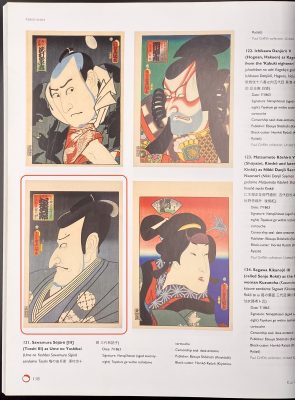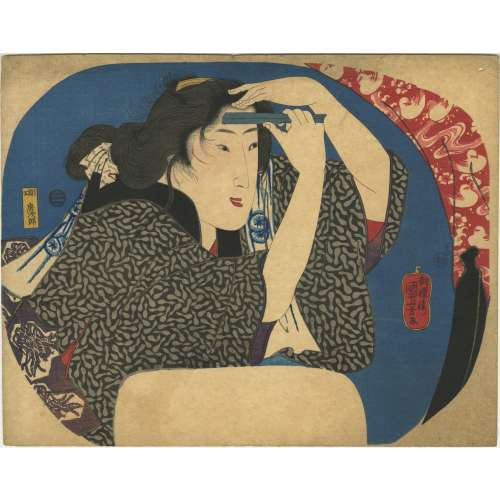Kabuki actor:
Matsumoto Kōshirō V [五代目松本幸四郎] (Japanese, 1764-1838); other names: Ichikawa Komazō III, Ichikawa Sumizō I.
Role:
Nikki Danjo (仁木弾正): "Evil retainer Nikki Danjo who plots to overthrow his lord in the play
Precious incense and the bush clover of Sendai (Meiboku sendai hagi)" [
R. Kruml].
Artist:
Utagawa Kunisada [歌川 国貞] a.k.a. Utagawa Toyokuni III [三代歌川豊国] (Japanese, 1786 – 1865).
Block cutter: Horikō (Kiyomizu) Ryūzō [彫工 柳三].
Publisher:
Ebisuya Shoshichi [恵比寿屋庄七], Kinshōdō (Japanese, fl. c. 1846 – 1883).
Year: 1863 (Bunkyū 3), 7th month.
Size: Vertical ōban, hōsho paper.
Signed:
Nanajuhassai (aged seventy-eight)
Toyokuni ga within toshidama cartouche.
Censor’s seal: date-aratame.
This print is from a series of portraits that Kunisada undertook very late in life and has been named
Kinshodo-ban yakusha okubi-e (Kinshodo’s Large-Head Actor Portraits) in reference to the publisher, Ebisuya Shochochi of Kinshodo. The series depicted great actors in their famous roles from the past and present.
Ref.: (1) [
LIB-1212.2017] Robert Schaap. Kunisada: Imaging, drama and beauty. — Leiden: Hotei Publishing, 2016, p. 118 and 167 (№ 42):

Ref.: (1) [
LIB-1197.2016] Arendie and Henk Herwig. Heroes of the kabuki stage: an introduction to kabuki with retellings of famous plays, illustrated by woodblock prints. — Amsterdam: Hotei Publishing, 2004; pp. 243-249.





























 Ref.: (1) [
Ref.: (1) [





